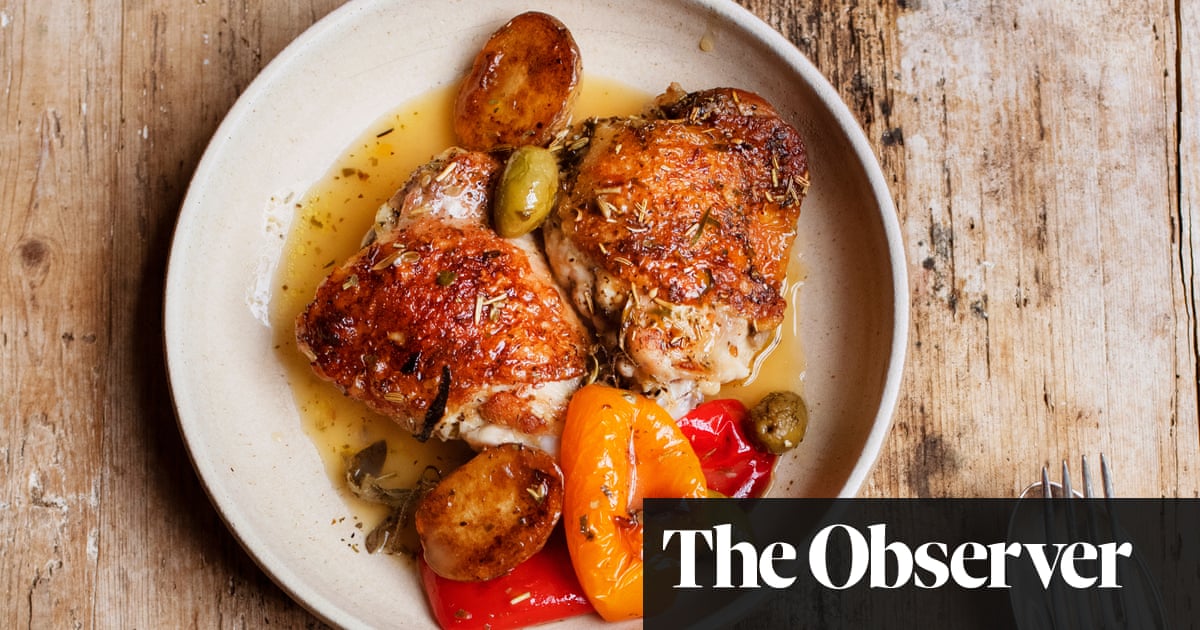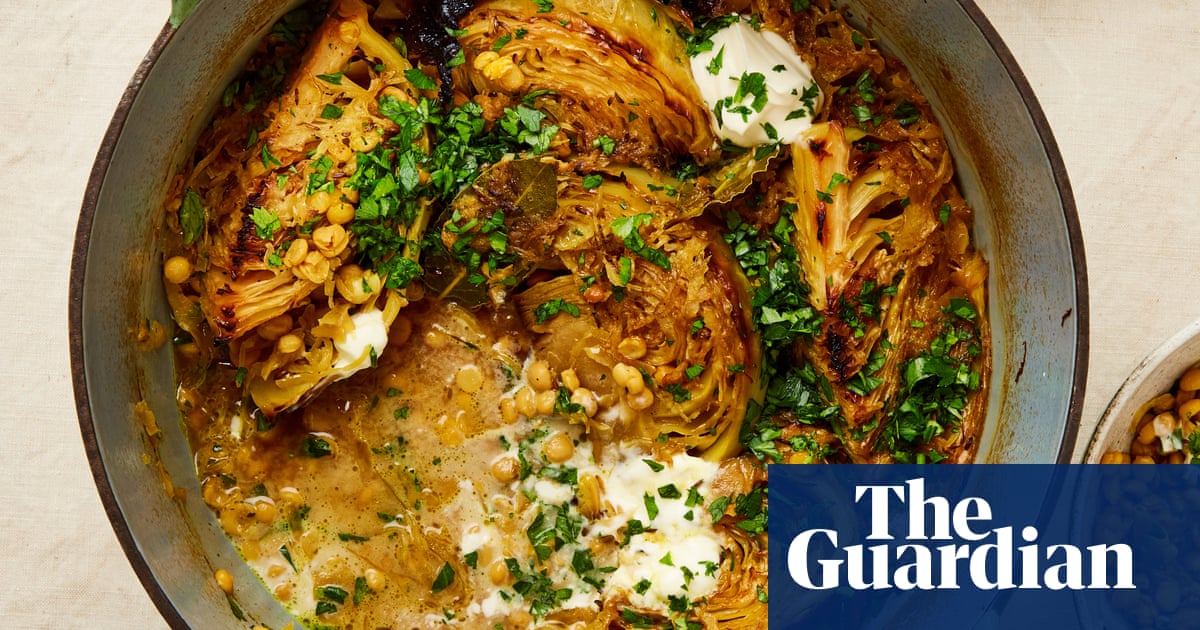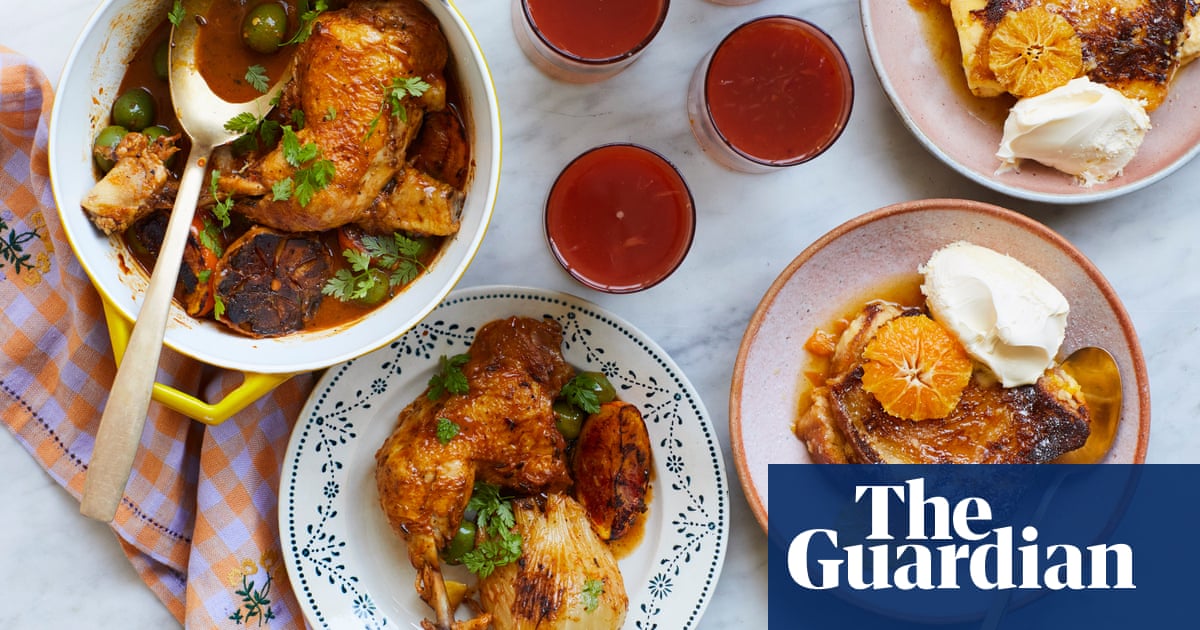
Christmas can be a stressful, combative time and the Oliver household – which Andi shares with her partner, Garfield Hackett, and regular visitor, her daughter Miquita Oliver, the TV presenter – is no different. The main source of contention is whether Andi allows help in the kitchen. “I’m going to say, ‘Yes I do,’” she says. “And when my daughter reads this she’s going to go: ‘Liar!’ But I feel that I do, I just like to keep my eye on them.” Then she thinks for a moment and admits: “Well, to be perfectly honest, I don’t really, no.”
Considering what usually ends up on their Christmas table, there are unlikely to be too many complaints. For OFM, Oliver, who presents BBC Two’s The Great British Menu, has created a festive menu that fuses classic elements from her Antiguan heritage with modern preoccupations of reducing waste, eating seasonally and offering delicious vegan options. She’s particularly pleased with the slow-roasted carrot and pumpkin main course, served with parsnip crisps and coconut chickpeas.
“Loads of people in my family don’t eat meat or fish,” she explains. “And in Caribbean cooking it’s not a new idea, veganism. They call it ‘ital’ and that’s how Rastafarians have eaten for decades.”
With Nat King Cole and Etta James supplying the soundtrack, and a steady flow of Hix Fix cocktails, Oliver will also serve saltfish topped with salted cucumber and root-veg fritters with a no-waste broth. “It feels royal,” she says. “Everything should feel special at Christmas. Everything that goes on the table should feel like it’s got a little party hat on.”
As for what the meaty main will be, there’s already a heated debate. Miquita always pushes for a traditional turkey; her mum favours a smaller bird, such as the spice-rubbed chicken featured here. Who will prevail? “Absolutely there will be a big argument,” laughs Andi. “And I will win!”
Winter herb and saltfish buljol, avocado and lemon-salted cucumber
Saltfish reminds me of every Christmas we ever had as kids. Mum used to make it the traditional Antiguan way, cooked up with tomato, herbs, peppers and a little heat running through. Or sometimes, on a fancier day we’d get saltfish buljol, which is another name for saltfish salad. It’s topped with citrussy salted cucumbers, it’s fresh, zingy and my absolute favourite way to have saltfish. This way of making saltfish is full of lovely woody floral herbs. There is a misconception that Caribbean food is all about heat, and ingredients people of European origin would not recognise, but this shows how much we love thyme, marjoram, oregano and a whole bunch of other stuff you can get in any shop or market in Britain.
Serves 4
salt cod fillets 500g, skinless and boneless
sweet green or yellow pepper 100g, grated
avocado 1 whole, diced (about 150g)
thyme 2 sprigs, picked
oregano 2 sprigs, picked and finely chopped
flat-leaf parsley 20g, finely chopped
red or green chilli 1 whole, medium-sized, medium heat, finely sliced with seeds
spring onions 3 or 4, thinly sliced
lime juice of 1, plus another squeeze of lime to serve
extra virgin British rapeseed oil 50ml
For the cucumbers
cucumber ½ (about 100g), peeled, deseeded and diced
lemon juice of ½
good rapeseed oil 50ml
Maldon sea salt a big pinch
black pepper a generous pinch
First, rinse the salt cod thoroughly and put it in a pot with cold water. Bring to the boil and strain off the water. Repeat this twice more, discarding the water each time, then set aside to cool. If you prefer it less salty, soak the salt cod in water overnight prior to the boiling and rinsing process.
Once cooled, flake the fish gently with a fork until no large chunks remain.
In a large bowl, place the grated peppers, avocado, herbs, chilli and spring onions with the lime juice and rapeseed oil, throw in the flaked fish and give everything a good mix-up.
In a separate bowl combine the diced cucumber, lemon juice and rapeseed oil, and a pinch of salt and black pepper, and combine thoroughly. Leave to one side for 15-20 minutes before serving.
Stack the salted cucumbers on top of the salt cod salad, give everything a good squeeze of lime and serve.
Root vegetable and onion fritters, leek broth
Crisp on the outside, fluffy on the inside – in Caribbean cooking we love a fritter. It’s a brilliant way for a dish with no meat to shine at the table. With this version I used parsnips because that’s what was available, but you can truly use any root vegetable you can lay your hands on – just make sure your batter doesn’t get too wet. If you’re worried, just add a little more flour.
Serves 4
For the fritters
parsnips 220g, or any other root vegetable (jerusalem artichoke, carrot, celeriac), peeled and grated (keep the peel for the broth)
onion 1 medium (about 150g), peeled and grated (keep the skins and ends for the broth)
green chilli 1, finely chopped
flat-leaf parsley a big handful, finely chopped (keep the stalks for the broth)
fresh oregano a big pinch, finely chopped (keep the stalks for the broth)
winter savory a pinch, finely chopped (you can use thyme or marjoram or any other woody herb)
lemon zest of 1
curry powder 1 generous tsp
plain flour 100g
eggs 2 medium, beaten
salt 2 pinches
ground black pepper 2 pinches
baking powder ½ tsp
bicarbonate of soda ½ tsp
cider vinegar 1 tsp
rapeseed, sunflower or vegetable oil about 1 litre, for deep frying
For the broth
leek 200g, roughly chopped
carrot 1, roughly chopped
fresh bay leaves 2
apple 40g (any kind), cored and roughly chopped
white miso 1 tsp
garlic 1 head, sliced in half through the middle
thyme, marjoram, or other woody herb 1 sprig
butter 70g, cold
Start with the broth. Take your chopped leek, carrots, herbs, bay leaves, apple, miso and garlic, plus all the leftover peels and ends from the fritter vegetables, and add to a saucepan with about 1.5-2 litres of water. Bring to a boil, then simmer on a low heat very gently for about an hour to get the most flavour out of it, then leave to one side.
Next, in a bowl thoroughly combine all the fritter ingredients and leave for 10 minutes to settle.
In a deep fat fryer, wok or other high-sided pan heat the rapeseed oil to around 190C – you can test if it’s hot enough by dropping a small cube of white bread into it, if it becomes golden then you’re good to go. Put a plate with kitchen paper on it to one side.
Once ready, gently slip spoonfuls of the fritter mixture into the oil. I use two spoons; load one up and slide it off with the other one, but be very gentle so you don’t splash yourself with the hot oil. It is important not to overcrowd the pan, leave enough room so you can gently turn them around a bit – I tend to cook about 5 or 6 at a time. Once deep golden-brown, remove from the pan and place the fritters to drain on the plate. Once the oil has drained you can keep the fritters warm in a low oven (around 100C) while you prepare the next steps.
Strain the broth through a colander or sieve leaving the vegetables and peelings behind, return the broth to the pan, bubble it up and add the cold butter to it to finish it off.
Plate up the fritters and serve the broth in a jug on the side. Pour the broth around the fritters on each plate at the table, just before eating – delicious!
Spice-rubbed roast chicken and ackee sweetcorn cream
We’ve all had a right old time of it recently, haven’t we? I just keep thinking that the idea of making a giant bird is a bit overwhelming for lots of us at this point, especially as many people will be cooking for a way smaller Christmas gathering than before.
I’ve come up with a beautiful tea brine for you to try on a relatively smaller Christmas bird. It keeps the meat moist and juicy, and starts packing in the flavour early on, then the spices lift the whole thing up to the level of special that you want. It is Christmas, after all.
Plus there’s creamed corn but not as you know it. Ackee is a peculiar not-sweet fruit that some will already be familiar with, often served with saltfish and fried dumplings. I recently discovered that when you cream it with sweetcorn it’s the most velvety, luxurious thing of beauty. Two of my favourite things; something simple made special and incredibly easy. A double win!
Serves 4
lemon 1, cut in half
organic free range chicken 1 x 2kg
ackee 1 x 540g tin, drained
sweetcorn 1 x 80g tin, drained
oat cream 200ml (if you can’t get oat, double dairy cream will work)
For the brine
water 1.5 litres
earl grey tea bags 3
clementines peel of 2
thyme 2 sprigs, picked
sugar 1 tbsp
table salt 2 tbsp
For the seasoning paste
ground cumin 1 tsp
paprika 1 tsp
cayenne pepper ½ tsp
garlic 2 cloves
spring onions 3
rapeseed oil 10ml
salt and pepper to taste
garlicky greens to serve
roast potatoes to serve
First make your brine. In a large pot, bring 1.5 litres of cold water to a rolling boil, add the earl grey tea bags, clementine peel, thyme, sugar and salt, then turn off the heat and refrigerate.
Rub the lemon halves all over the chicken and place inside the cavity. Now put the chicken into the brine mixture making sure it is covered, and leave for a minimum of 4 hours in the fridge, or, even better, overnight.
Take your seasoning paste spices, garlic, onions, oil and seasoning and blitz together in a food processor to make a thick paste. Add a little more oil if the paste is too thick.
In the morning (or after 4 hours), preheat the oven to 160C fan/gas mark 4. Remove the chicken from the brine, pat dry, rub the seasoning paste all over it, season with salt and pepper and place in a roasting tin in the oven for 1 hour 30 minutes. To check if the chicken is cooked, insert a skewer into the thigh – if the juices that escape run clear, then it is done.
When the chicken has been cooking for about an hour, drain the ackee and sweetcorn separately.
In a non-stick frying pan gently toast your sweetcorn until it becomes slightly charred, then add your ackee for 1-2 minutes, mixing them both together.
Now put your ackee and corn into a blender with the oat cream and blitz until smooth. Season with salt and pepper to taste.
Remove the chicken from the oven and sit to rest for 10-15 minutes. Heat the ackee-sweetcorn cream gently over a low heat, carve the chicken and serve with some garlicky greens and roast potatoes.
Slow-roast carrot and pumpkin, golden butter coconut chickpeas and parsnip crisps
Slow roasting the pumpkin and carrot brings out the natural sweetness of the produce, and when you combine it with the coconut chickpea sauce it’s complex, soothing and bursting with flavour. Top with parsnip crisps for texture and it’s a plant-based dish worthy of any Christmas feast.
Serves 4
carrots 200g, peeled and roughly chopped into 3-5cm pieces
pumpkin 400g, peeled and roughly chopped into 3-5cm pieces
garlic 1 head, cut in half through the middle
Maldon sea salt flakes a good pinch
cumin seeds 1 tsp
thyme 2 sprigs, picked
red and green chillies 2, long, mild, finely chopped
lemon zest of 1
rapeseed oil 100ml
fresh ginger thumb-sized piece, grated
parsnip 1
oil 1 litre, for frying
For the coconut butter chickpeas
onion 1, thinly sliced
garlic 3 cloves, finely chopped
ground turmeric 2 tsp
rapeseed oil 20ml
coconut milk 1 x 400ml tin
chickpeas 1 x 240g tin, drained
In a bowl place your chopped vegetables and garlic halves, sea salt, cumin seeds, thyme, chilli and lemon zest, and drizzle over the rapeseed oil. Mix together with the grated ginger so that everything is coated.
Transfer everything on to a baking sheet and roast at 160C fan/gas mark 4 for 30 minutes or until golden.
While your vegetables are cooking, take your parsnip and using a vegetable peeler, shave the whole root lengthways into very thin slices and leave to one side.
Add the oil to a wok or high-sided pan and heat to around 190C (or until a piece of white bread turns golden when dropped in). Put a plate with kitchen paper on it to one side. Once the oil is hot enough, carefully slip your parsnip shavings into the oil, and fry until golden and crisp. Once cooked, very carefully remove from the hot oil with a slotted spoon or spider and leave to drain on the kitchen paper. Season with a little salt.
Now make your golden chickpeas. Sweat the onions and garlic with the turmeric in a little rapeseed oil until soft – the pan will start to release an enticing aroma after a few minutes. Now stir in the coconut milk and cook gently for a further 4-5 minutes.
Finish by stirring in the chickpeas and heating through for a final 4 minutes or so. Spoon the chickpeas over your roasted vegetables, with the parsnips crisps scattered on top.
Uncle Arnold’s rum and sultana pear cake
My uncle Arnold passed away recently, a man I loved dearly. He taught me how to drink good rum and he was a gardener most magnificent. So for him I have devised a pudding that incorporates the last pears I picked from his garden and, of course, plenty of delicious honeyed golden rum. It’s a long bake but it’s worth every glorious minute.
Serves 4-6
sultanas 250g
gold rum 350ml
mixed spice 1 good pinch
vanilla extract 20ml
conference pears 4, peeled
butter 450g
brown sugar 250g
stem ginger in syrup 100g
dates 400g
caster sugar 230g
eggs 2
self-raising flour 400g
baking powder 10g
gingernut biscuits 80g
whipped cream or custard to serve
Cover the sultanas in 250ml of the gold rum, and stir in the mixed spice and half of the vanilla extract. Leave to soak overnight or for a minimum of 3 hours.
Slice the pears into quarters lengthwise and cut out the core and any pips. Line a tall 23cm cake tin with baking paper and layer the pears in the bottom in a fan shape or whichever way you fancy.
In a saucepan, melt 200g of the butter, the brown sugar and the remaining 100ml of the rum on a gentle heat until the sugar has melted. Pour two-thirds of the syrup over the pears so they are covered.
Preheat the oven to 150C fan/gas mark 3½.
Strain the rum-soaked sultanas. In a food processor, blitz the stem ginger and dates, or chop roughly by hand, then mix with the rum-soaked sultanas.
Beat the remaining butter and the caster sugar together until pale and fluffy, add the rest of the vanilla and the eggs one by one until combined. Tip in the chopped fruit and beat again. Finally beat in the flour and baking powder until thoroughly combined.
Pile the cake mix into the tin on top of the pears and syrup, and give the tin a gentle shake from side to side to even out the mixture, or use a spatula or back of a spoon, and allow to settle.
Crush the ginger biscuits to a crumb with a rolling pin or in a food processor, and sprinkle over the top of the settled cake mix, then cover with a sheet of tin foil.
Slip it into the oven for about 2 hours and 30 minutes or until a skewer comes out clean when you stick it in the middle.
Remove from the oven and leave to cool in the tin.
Once cooled, run a knife around the edge of the cake, lay a plate over the top, tip it upside down and the whole thing should come out. Gently peel back the paper, pour over the remaining syrup and serve sliced with whipped cream or custard.












